|
Pickett's Charge
| Pickett's Charge |
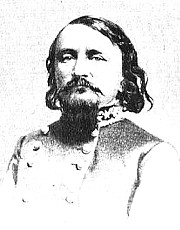
|
| General George Pickett |
|
The Fame of Pickett's Charge
"General, I have no division..."
-Major General George Pickett to General Robert E. Lee at Gettysburg, July 3, 1863 |
Introduction
Of all of the events that occurred during the three days of the Battle of Gettysburg, few have been more studied, debated, celebrated,
and romanticized than Longstreet's Assault, more popularly known as "Pickett's Charge". Coordinated by Lieutenant General James Longstreet, the attack has been referred to as Longstreet's Grand Assault, the Pettigrew-Pickett Charge, and even the High Water Mark of the Rebellion by many historians. Yet it is Major General George Pickett's name that has forever been attached to the High
Water Mark of the battle,
for his troops- "the flower of Virginia manhood"- were more glorified for their participation in the charge by Southern and
Northern writers in the years following the battle.
"Don't forget today that you are from Old Virginia!" Famed words of Maj. Gen. George Pickett to his division
prior to the charge at Gettysburg.
| Pickett's Charge |
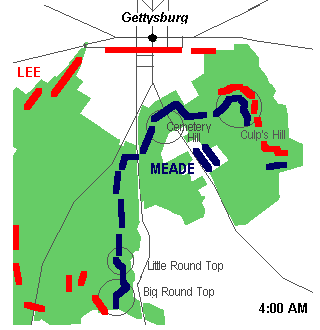
|
| Pickett's Charge, Cemetery Ridge, Battle of Gettysburg |
(Right) Map of Pickett's Charge on July 3. After the fighting at Culp's Hill, Lee concentrated on breaking
the Union center on Cemetery Ridge at Gettysburg.
| Pickett's Charge |
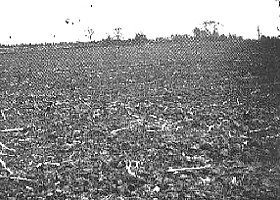
|
| (Gettysburg NMP) |
Pickett's Charge is named after Maj. Gen. George Pickett, one of three Confederate
generals who led the assault under Longstreet, and the names of the places associated with the charge are deeply indented
on the American conscience. Every summer, "The Angle" and "High Water Mark" are crowded with visitors who come to commemorate the event and ponder those
terrible minutes when American killed American in a desperate contest of wills and ideals. So much carnage in such a small
place; it is difficult for us today to realize the horror those young men faced, and how quickly the hopes of the North and
South were determined in this famous battle.
(Left) Picture of The High Water Mark and Angle in 1870-72. This view
from the Emmitsburg Road shows the ground over which Garnett's brigade charged to reach the Angle and Cushing's guns.
Pickett's Division was one of the largest in the Army of Northern Virginia. Having been assigned to defenses in the Richmond area in 1863, Pickett's troops
were veterans of several campaigns and joined the army as it made its way toward Maryland and Pennsylvania. Pickett was anxious
that he would not get to see any of the fighting during the campaign and was "filled with excitement" when he was ordered to move his three brigades
to the front lines on the morning of July 3rd.
With all preparations completed, Pickett's soldiers marched across the shell-swept
field, temporarily broke the Union line, and returned to Seminary Ridge broken and shattered. The charge had lasted barely 50 minutes, but Pickett's
Virginians had achieved a remarkable high point of honor and glory in Southern heritage and the story of Gettysburg. Union
losses were 1,500, but the Confederates suffered some 6,500 casualties. Pickett had lost over one-half of his division in
killed, wounded, missing, and captured including all three of his brigadier generals in the charge. (See also Napoleonic Tactics and The American Civil War Artillery.)
| Battlefield Map of Pickett's Charge, July 3, 1863 |
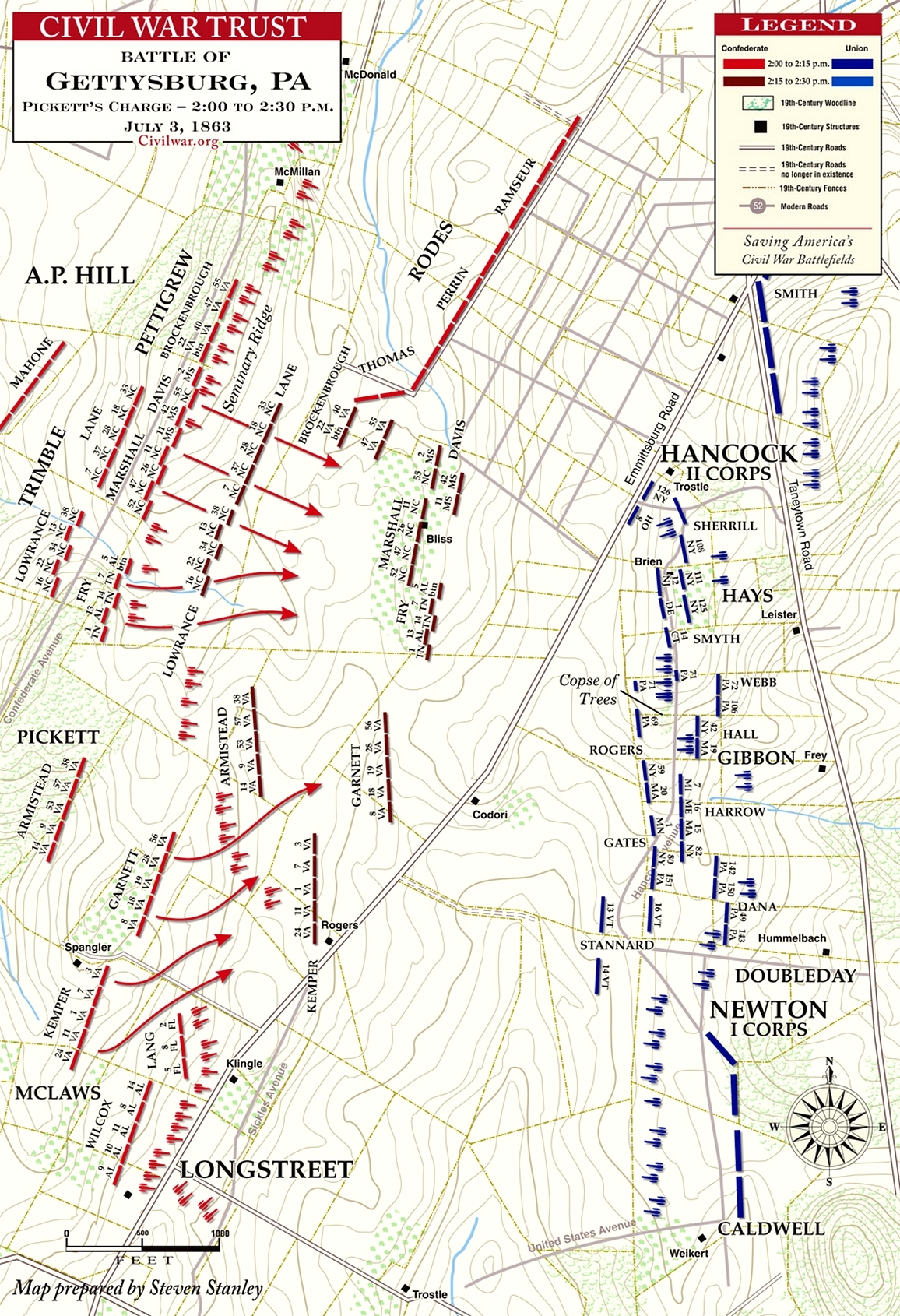
|
| Pickett's Charge Map at Battle of Gettysburg, July 3, 1863 |
| Map of Pickett's Charge |
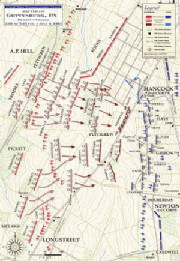
|
| Pickett's Charge |
(Right) Map of Union and Confederate Battlefield Positions during
Pickett's Charge from 2 P.M. to 2:45 P.M. on July 3, 1863. "Advance and Charge." Courtesy Civil War Preservation
Trust.
Description
After Confederate attacks on both Union flanks had failed the day and night
before, Lee was determined to strike the Union center on the third day. On the night of July 2, General Meade correctly predicted
at a council of war that Lee would try an attack on his lines in the center the following morning.
Pickett's Charge, an infantry assault ordered by Confederate Gen. Robert E.
Lee against Maj. Gen. George G. Meade's Union positions on Cemetery Ridge on July 3, 1863, occurred on the last day of the Battle of Gettysburg during
the American Civil War. Its futility was predicted by the charge's commander, Lt. Gen. James Longstreet, and it was arguably
an avoidable mistake from which the Southern war effort never fully recovered psychologically. The farthest point reached
by the attack has been referred to as the high-water mark of the Confederacy.
At the time of Pickett's Charge
it was 87 degrees, which was also the maximum temperature at Gettysburg for the month of July 1863.
The infantry assault was preceded by a massive artillery bombardment
that was meant to soften up the Union defense and silence its artillery, but it was largely ineffective. Approximately 12,500 men in nine infantry brigades advanced over open fields for three quarters of a mile under
heavy Union artillery and rifle fire (Union Artillery at Gettysburg and Confederate Artillery at Gettysburg). Although some Confederates were
able to breach the low stone wall that shielded many of the Union defenders, they could not maintain their hold and
were repulsed with over 50% casualties, a decisive defeat that ended the three-day battle and Lee's campaign into Pennsylvania.
Years later, when asked why his charge at Gettysburg failed, General Pickett replied: "I've always thought the Yankees had
something to do with it."
| Map of Pickett's Charge |
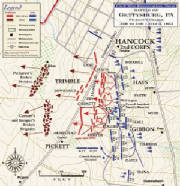
|
| Pickett's Charge |
(Right) Map of Union and Confederate Battlefield Positions during Pickett's
Charge from 3 P.M. to 4 P.M. on July 3, 1863. "Repulse and Retreat." Courtesy Civil War Preservation Trust.
Casualties
Pickett's Charge was a bloodbath. While the Union
lost approximately 1,500 killed and wounded, the Confederate casualty rate was greater than 50%. Pickett's division suffered
2,655 casualties (498 killed, 643 wounded, 833 wounded and captured, and 681 captured, unwounded). Pettigrew's losses were
estimated at 2,700 (470 killed, 1,893 wounded, 337 captured). Trimble's two brigades lost 885 (155 killed, 650 wounded, and
80 captured). Wilcox's brigade reported losses of 200, Lang's roughly 400. Thus, total losses during the attack were 6,555,
of which at least 1,123 Confederates were killed on the battlefield, 4,019 were wounded, and a good number of the injured
were also captured. Confederate prisoner totals are difficult to estimate from their reports; Union reports indicated that
3,750 men were captured. (See also Battle of Gettysburg : Strength of Armies and Battle of Gettysburg : Infantry, Cavalry, Artillery, Weapons, and Tactics.)
| Pickett's Charge |
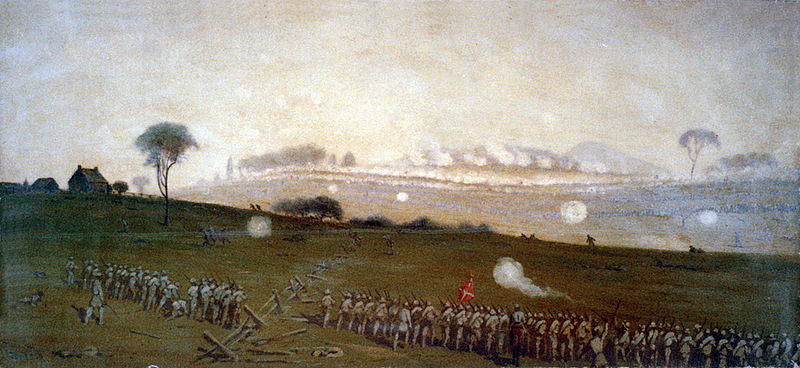
|
| Artwork of the Civil War Battle of Gettysburg |
(Drawing) Pickett's Charge from a position on the Confederate line looking toward the Union lines, Ziegler's
Grove on the left, clump of trees on right, painting by Edwin Forbes. Courtesy Library of Congress.
| Pettigrew-Pickett Charge Map |
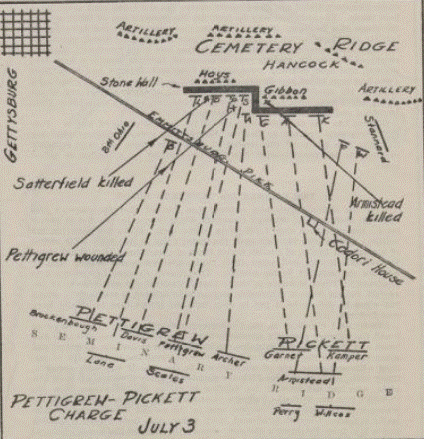
|
| Vintage Pickett's Charge Map |
(Right) Vintage map of the seldom
referred to “Pettigrew-Pickett Charge” on July 3, 1863. Courtesy North Carolina at Gettysburg
and Pickett's Charge a Misnomer, 1921, by Walter Clark (1846-1924).
It was ironic to some that with so much destruction in the
ranks and among the high-ranking officers that General Pickett escaped the battle without a scratch. (The general's location
during the charge would later become a heated debate among some of the participants.) The fate of his three generals was 'each
very different from the other:'
The Battle of Gettysburg was a turning point in the Civil War, the Union
victory in the summer of 1863 that ended General Robert E. Lee's second and most ambitious invasion of the North. Often referred
to as the "High Water Mark of the Confederacy", it was the war's bloodiest battle with 51,000 casualties. It also provided
President Abraham Lincoln with the setting for his most famous address. See Pennsylvania Civil War History.
Aftermath

Richard Brooke Garnett. Disregarding the advice of fellow officers,
Garnett rode into the attack and led his troops across the Emmitsburg Road into the storm of canister from Union guns. Garnett
was seen cheering his soldiers forward in the thick smoke, urging them on toward the stone wall. No one ever saw the general
alive again. His riderless horse returned to Seminary Ridge, the saddle speckled with the general's blood. Garnett's body
was never recovered and mystery has surrounded his fate ever since, though his body was most likely interred on the field
with the dead from his brigade. General Garnett's sword was later found in a Baltimore pawn shop by former Confederate general
George H. Steuart, who returned the treasured relic to the Garnett family. Unfortunately, regarding General Richard Brooke
Garnett, there is no known photograph in existence. The photographs in circulation
are believed to be Richard Garnett's cousin, Confederate general Robert S. Garnett, who was the first general officer killed
during the American Civil War. The photo adjoining this narrative is often stated to be "Richard" Garnett (it is
circulated widely), but it too is believed to be General Robert S. Garnett.

James Lawson Kemper. Despite what appeared to be a mortal wound, General Kemper beat the
odds and survived. Captured by Federal troops after the retreat from Gettysburg, Kemper was paroled and exchanged. Promoted
to major general in 1864, Kemper commanded the reserve forces of Virginia until the close of the war, after which he returned
to his law practice.
He received the Democratic nomination for the governorship of Virginia and served as that state's governor
from 1874 to 1877. He then returned to his law practice, but kept his hand in state politics and often spoke on legislative
politics and state government. Kemper died in 1895 and is buried in Orange County, Virginia.

Lewis Armistead. The only brigade commander in Pickett's Division to breach the Union
line, General Armistead was shot in the arm by Union rifle fire after placing a hand on one of Lt. Cushing's
cannon in the center of the Angle. He was subsequently taken prisoner by Federal forces and taken by ambulance to a Union
field hospital. Despite the efforts of Union surgeons, the general died on July 5 and was buried near the field hospital.
His remains were later recovered by friends who had the general interred at St. Paul's Church in Baltimore.
| Pickett's Division is repulsed on July 3, 1863 |
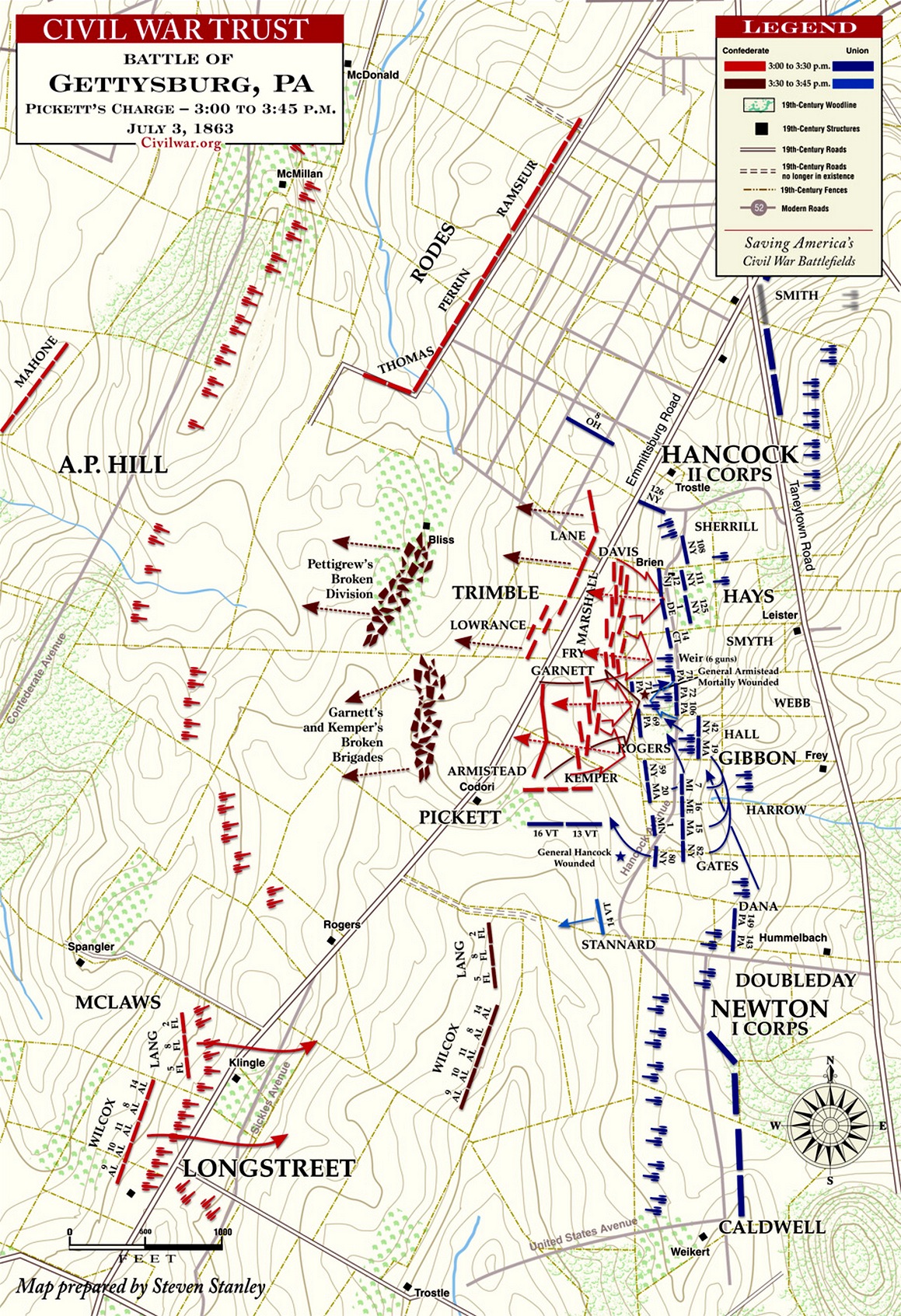
|
| Pickett's Charge is repulsed on July 3, 1863 |
| General Lewis Armistead Monument |
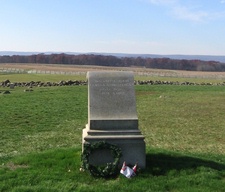
|
| Pickett's Charge |
(Right) The monument on the Gettysburg Battlefield marking the approximate
location where General Armistead was fatally wounded during Pickett's Charge. The wall behind the monument marks the Union
lines.
As for General Pickett, he did not
enjoy great success as a field commander after Gettysburg. Distraught over the losses in his command, Pickett led his troops
back to Virginia where the weariness of the harsh campaign eventually wore off and his spirits were rejuvenated with
the return of Corse's Brigade to his division.
That fall Pickett was assigned to command the Department of Virginia and
North Carolina during which time he took a short leave of absence to marry his third and most adoring wife, LaSalle Corbell.
The couple eventually had two children. General Pickett's duties placed him in command of numerous defensive lines around
Richmond, Petersburg, and southeast Virginia, a post he held until 1864 when he returned to the field in command of his old division.
On April 1, 1865, Pickett was in command of Confederate troops placed at the strategic crossroads of Five Forks, Virginia, several miles west of Petersburg. That morning, General Pickett accepted an invitation to attend a shade bake picnic with fellow officers along the banks
of Hatcher's Run, at a site far behind the front lines and out of touch with their men.
| Sketch of Pickett's troops |
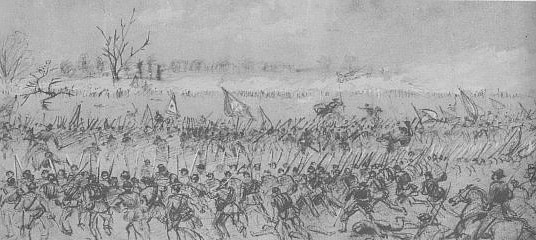
|
| Charge of the Fifth Corps on Pickett's troops at Five Forks, April 1, 1865 |
Shortly after 4 PM, a combined force of Union infantry and cavalry stormed
the Southern position and broke through the thin line. Pickett raced to the front but it was too late. His command was in
a shambles and despite the efforts of his brigade officers to stave off the Union assault, there was little he could do but
rally the survivors and withdraw from the battlefield. With Five Forks in Union hands, the last supply route into Petersburg
was lost and the city was forced to be abandoned.
| Battle of Gettysburg |
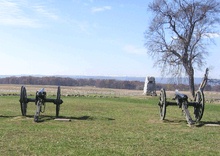
|
| Pickett's Charge |
(Right) Cannons representing Hancock's defenses that were stormed by Pickett's
Charge.
Pickett's absence from the front line at Five Forks possibly inflamed the
ire of General Lee, who had ordered Five Forks to be held at all costs. The Army of Northern Virginia retreated from the Richmond
and Petersburg lines and moved west toward Danville, Virginia, hotly pursued by two Union armies and a massive cavalry force.
On April 6 at Sailor's Creek, Virginia, Pickett's command, along with troops under Generals R. H. Anderson, Richard Ewell, and Joseph Kershaw, was nearly encircled by a combined force of Union cavalry and infantry.
An attempt to break out failed and the Confederate position folded, costing Lee over one-third of his army. Only several hundred
panicked Confederates were able to get out of the trap and they were personally rallied by General Lee. General Pickett and
his staff narrowly escaped capture as night fell. Pickett's escape without bringing out his troops may have been the final
straw for Lee who relieved Generals Anderson, Bushrod Johnson, and Pickett of command two days later, though Lee's order evidently
never reached Pickett in the confusion of the retreat. The general remained with his division as the army wearily marched
to Appomattox Court House, where he formally surrendered and bade goodbye to the soldiers of his old command.
General Pickett returned to Richmond where he was faced with monumental decisions
of providing for his family. He attempted farming for several years before he finally accepted work with an insurance company
based in New York. As an agent for the company, Pickett sold policies from his home in Richmond and worked with insurance
agents in other Virginia cities from whom he drew a commission. The life of an insurance agent was distasteful to the man
who once led thousands of soldiers into battle, but he continued to work with the company to support his family until his
death in 1875.
| Field at Pickett's Charge |
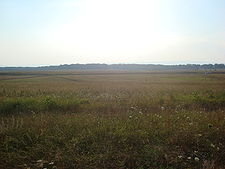
|
| Battle of Gettysburg |
(Right) The field of Pickett's Charge from the Union line, near the High
Water Mark. The ridge of trees in the background is where the Confederate line was positioned.
Analysis
In a journalistic sense, the charge at Gettysburg was to be General
Pickett's most important contribution to the Southern cause. Southern writers heralded his Virginians who made the attack
against impossible odds, one writer placing the general in the role of a tragic hero who did what he could despite the mistakes
and miscalculations of others. Controversies surrounding his actions during the Appomattox Campaign did not directly affect
the general who was held in high regard by the officers and men who served under him. Apparently embittered by the destruction
of his division at Gettysburg and uneasy with the awkward relationship with his former army commander, Pickett chose not to
openly discuss his career as a Confederate officer or what happened on that fateful July afternoon in Pennsylvania. Yet the
general never reconciled the losses his command suffered at Gettysburg, and never forgave Lee for ordering so many of his
young Virginians into the last great charge that today bears his name.
| The Copse of Trees on Cemetery Ridge |
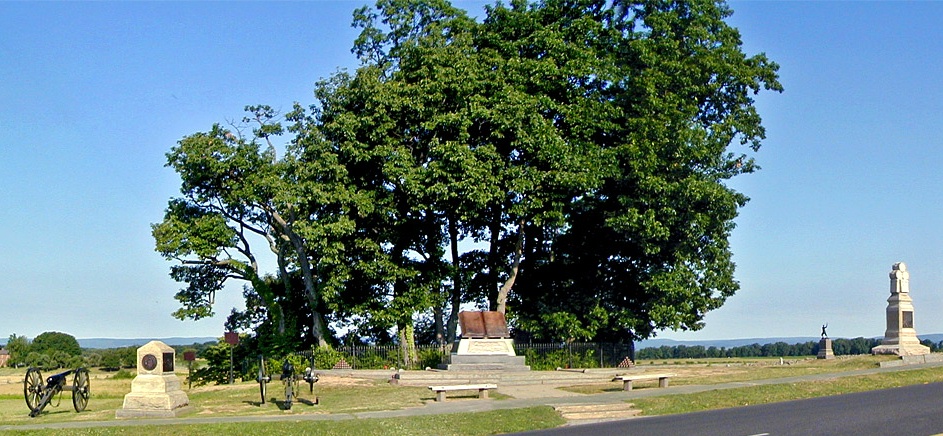
|
| High Water Mark, Pickett's Charge, Battle of Gettysburg |
| The High Water Mark |
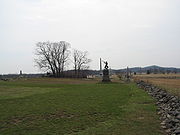
|
| Pickett's Charge |
(Right) The High Water Mark, viewed from the north. The "copse of trees"
is the small group of trees in the left center.
The charge was not without controversy (even before it began) and the debate
as to the assault's merits have been argued over and over again. Questions quickly arose soon after the battle as to who was
responsible for the failure. A few unnamed sources who favored the Virginians blamed the disaster on the lack of support from
Pettigrew's and Trimble's columns, criticisms that first appeared in newspapers in the fall of 1863. The accusations caused
hard feelings between commands and served no purpose other than to confuse facts surrounding the charge. After the war, the
conflict took a more personal side when a number of writers accused the North Carolinians of Pettigrew's division of cowardice
and not going into the charge as they were "untried and green troops" (the accusations were baseless). The debate grew
bitterer as time passed because numerous writers looked to Gettysburg as the
turning point of the war in Southern fortunes. The arguments had cooled some by the turn of the century. But in 1903, Samuel
A. Ashe, a North Carolina writer, wrote a scathing article published in a Richmond newspaper in which he demanded to know
why North Carolina troops were continually slandered by Virginia veterans. He also broached the subject of Pickett's whereabouts
during the attack, blaming the failure of the charge on the general for his lack of command. The flame became an inferno as
former staff officers rushed to Pickett's defense. Cruel innuendo followed including a condemning statement attributed to
Pickett that had no factual base. Yet the hard feelings did not easily pass away and the bitter debate resurfaced and
continued until the last veteran of the charge passed away. Interestingly enough, the Southern spirit of invincibility did
not die during the Civil War; only a few Southern writers ever gave the Union defenders of Cemetery Ridge any credit for breaking up the attack.
| Painting of Pickett's Charge |
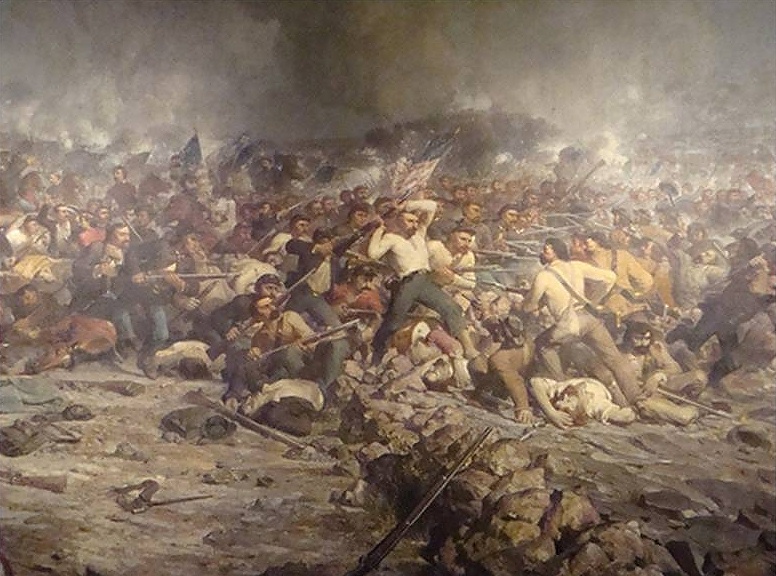
|
| Pickett's Charge, by Peter Frederick Rothermel, circa 1870 |
(Courtesy State Museum of Pennsylvania, Harrisburg, Pennsylvania.)
"Only here in the United States could former foes meet as
friends..."
The culmination of Lee's last hopes for victory in Pennsylvania, "Pickett's
Charge," was thwarted by a number of factors including poor staff work, superior organization and control of Union artillery,
massed infantry lines against rifled weapons, and a Pennsylvania brigade standing on their native soil in the Angle that fought
for every inch of ground. The Philadelphia Brigade was composed of regiments raised in the city and counties surrounding
Philadelphia. The celebrated brigade was first led by Colonel Edward Baker and fought under several different commanders through
the terrible campaigns of 1862 and 1863. New York-born Brigadier General Alexander Webb led the brigade at Gettysburg. Assigned
to command the Philadelphians barely a week before Gettysburg, Webb distinguished himself during the battle and was wounded
on July 3 at the height of Pickett's attack. General Webb received the Medal of Honor for his courage under fire, though
he was not a favorite among the officers and men of his brigade who viewed the officer as a military appointment over a former
commander who was discharged without just cause.
| General George Pickett |
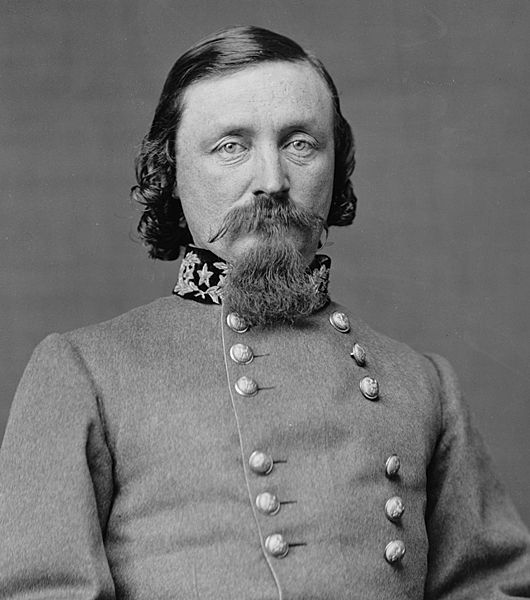
|
| (January 1825 -- July 30, 1875) |
(Right) Maj. Gen. George Pickett, ca. Civil War. LOC.
After Gettysburg, the Philadelphians fought through the Wilderness Campaign, Cold Harbor and to the outskirts of Petersburg. It was here that two of the brigade's
regiments, their term of enlistment having expired, were mustered out of service and journeyed home to a hero's welcome.
The remaining two regiments, including the 69th Pennsylvania Infantry, which had held a position along the stone wall on July
3, continued in service through the end of the war at Appomattox. In 1887, the veterans of that regiment planned to erect
a monument at Gettysburg where they'd held the line that hot summer afternoon. Their interest sparked the idea for an association
composed of veterans of the old brigade, and in 1887 the Philadelphia Brigade Association was formed. One of the first
matters brought before the association was the intention of a group of Southern veterans of Pickett's Division to also place
a memorial at Gettysburg. The Philadelphians extended an invitation to the newly formed Pickett's Division Association
to meet on the Gettysburg Battlefield, "in a spirit of 'Fraternity, Charity, and Loyalty.'" The Southerners accepted the invitation
to meet with their former foe at Gettysburg, but heated debates thwarted the efforts of those in favor of the summer meeting
and a disappointing meeting with the Gettysburg Battlefield Memorial Association sealed their decision not to go.
| The High Water Mark |
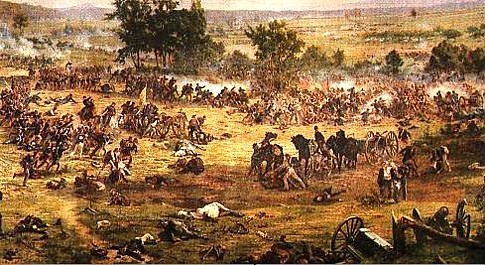
|
| Painting of Pickett's Charge |
(Gettysburg Cyclorama) General
Armistead leads his soldiers into the Angle as Union troops rush forward to stop the breach in the Union line. The "High Water
Mark" is the group of trees in the center. From the Gettysburg Cyclorama at Gettysburg
National Military Park.
Courtesy National Park Service.
| High Water Mark, Cemetery Ridge |
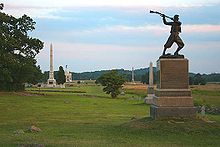
|
| Battle of Gettysburg: The Charge! |
(Right) Cemetery Ridge, looking south along the ridge with Little Round Top
and Big Round Top in the distance. The monument in the foreground is the 72nd Pennsylvania Infantry Monument.
Upon hearing of their decision, John W. Frazier, secretary of the Philadelphia
Brigade Association, authored a letter to the Pickett's Association urging them not to reject the invitation to the reunion.
Frazier went so far as to offer help for the Southern veterans- to get their monument erected at their desired location at
Gettysburg. After some debate, the invitation was re-accepted and a number of Southerners made plans to visit Gettysburg as
guests of the Philadelphia Brigade Association.
| Pickett's Charge Battle Map |
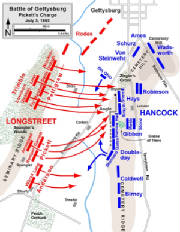
|
| Pickett's Charge |
(Left) Battlefield Map of Pickett's Charge.
A train bearing 500 veterans of the Philadelphia Brigade, including wives
and children, left Philadelphia on July 2 and arrived at the Gettysburg Train Station later that day. A second train arrived
two and one half hours later, bearing the Southern guests who were surprised and pleased by the greeting they received. Lining
the street were the Philadelphians, resplendent in white pith sun helmets, who welcomed the Confederate veterans with cheers
as a band struck up the tune "Dixie".
Formed into ranks, the two groups marched side by side up Carlisle Street
and into the center of town where they stood face to face and shook hands. A Northern writer observed: "Pickett's Division,
for the first time, was in undisputed possession of Gettysburg."
The old Confederates were treated with high honors by an excited group of
Union veterans eager to show their admiration and respect. Though the day was beastly hot, the veterans stood in the square
to listen to orations and speeches on behalf of both North and South. Among the honored guests was General Pickett's widow,
LaSalle Corbell Pickett and her son.

|
| Mrs. Pickett |
(Right) LaSalle Corbell Pickett (1843-1931). Mrs. Pickett would survive her husband by more than a half
century before her passing in 1931. Remaining a widow after General Pickett's death in 1875, Mrs. Pickett would become a
well-known public speaker while also authoring many works about the Lost Cause.
The general's widow was the most famous personality of the meeting at Gettysburg and held in high regard
by veterans of both associations. On July 4th, she greeted every veteran of the association named for her late husband and
walked the field with them as they made their way across the Codori Farm and up to the Angle.
Good feelings were everywhere and extended over into the next day when the
former soldiers marched out of Gettysburg and to the Angle where the veterans of the 69th Pennsylvania dedicated their monument.
There were more speeches to follow and the presentation of a flower arrangement and sentiment to Mrs. Pickett. The dedications
and speeches lasted for several hours while the crowd broiled under a hot sun. The afternoon festivities ended with adjournment
for refreshments being served under the shade of the Copse of Trees. Included were chilled kegs of beer which, no doubt, added
to the merriment of the participants in blue and gray that afternoon. Some of the veterans camped in tents erected near the
High Water Mark and pandemonium broke out at midnight when an impromptu fireworks display began in early celebration of the
4th of July.
| Veterans Reunion of Pickett's Charge |
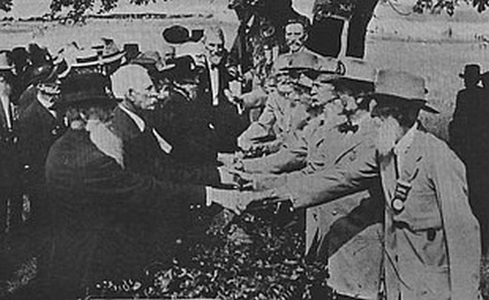
|
| 50th Anniversary of Pickett's Charge in 1913 |
| 1887 Reunion of Pickett's Charge. |
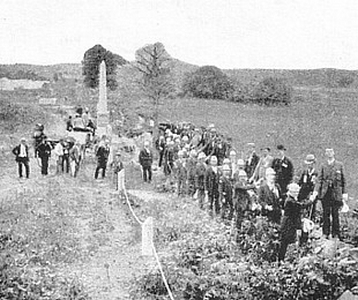
|
| Pickett's Veterans at Gettysburg Reunion in 1887 |
(Left) Webb's and Pickett's veterans shake hands at the stone wall, July 4, 1887. Courtesy McDermott, Brief History of the 69th Regiment. The
following day, the Southerners paraded across the fields, the scene of their great charge 24 years gone, and up to the gray
stone wall; behind the wall stood the helmeted Philadelphia Brigade Association veterans with extended hands. The two sides
met and shook hands, not as former foes, but as Americans. Reconciliation had come at last to these men who had sacrificed
so much on these bloody fields. (Right) Fifty years after the battle, the veterans of Pickett's Division Association
and the Philadelphia Brigade Association shake hands in comradeship over the stone wall
at the Angle. Courtesy Pennsylvania Historical and Museum Commission.
In 1938, seventy five years after the fight, at the last great reunion of the Blue and the Gray
at Gettysburg, a small group of veterans from Virginia and Pennsylvania met near the "Angle". As cameras rolled and clicked, the old gentlemen shook hands over the stone
wall where General Hays' Division stood on July 3, 1863 during Pickett's Charge. Though it is unknown whether any of these
veterans were actually present during the fighting at the Angle, this particular photograph was used to publicize the event
and illustrate the last meeting of the two associations that had met at the Angle up to 1913. By 1938, there were barely a
handful of veterans surviving from either army, who had actually been at Gettysburg seventy five years before. Twenty years
prior to this reunion, the First World War had ended, and three years later, in 1941, Pearl Harbor would be attacked and the
nation would be thrust into the war of all wars.
(Sources and related reading below.)
Recommended Reading: Gettysburg,
by Steven W. Sears (640 pages) (2004). Description:
This authoritative history of the Battle of Gettysburg opens during the summer 1863, and the setting was Richmond, Virginia,
the Confederate capital; putting their heads together were President Jefferson Davis, General Robert E. Lee, and the Confederate
Secretary of War. The Confederacy badly needed a victory because the stronghold at Vicksburg, Mississippi, was certain to
fall to Union forces sometime soon. The plan that emerged from the session was to send the Army of Northern Virginia on an
offensive across the Potomac River. The Confederate offensive abruptly failed, and Gettysburg represented the turning point
of the war. Sears, author of a half-dozen Civil War books and a former editor of American Heritage magazine, leaves no stone
unturned in his reconstruction of the battle, from preparation on both sides to the reasons for the Confederate loss. Readers
thrilled by the minute details of battlefield maneuvers will be thoroughly engaged. Continued below.
Sears casts his net wide, according
to Booklist, beginning with Lee's meeting with Davis in May 1863, where he argued in favor of marching north, to
take pressure off both Vicksburg and Confederate logistics. It ends with the battered Army of Northern Virginia re-crossing
the Potomac some two months later, a near-run on both sides as Meade was finally unwilling to drive his equally battered Army
of the Potomac into a desperate pursuit. In between is the balanced, clear and detailed story of how 60,000 men became casualties,
and how the winning of Confederate independence on the battlefield was put forever out of reach. The author generally is spare
with scapegoating, although he has little use for Union men Dan Sickles (who advanced against orders on the second day) or
Oliver Howard (whose Corps broke and was routed on the first day), or Richard Ewell of the Confederacy, who decided not to
take Culp's Hill on the first night, when that might have been decisive. Sears also strongly urges the view that Lee was not
fully in control of his army on the march or in the battle, a view borne out in his gripping narrative of Pickett's Charge,
which makes many aspects of that nightmare much clearer than they have been before. Drawing on original source material,
from soldiers' letters to official military records of the war, Stephen W. Sears's Gettysburg is a remarkable and dramatic
account of the legendary campaign. He takes particular care in his study of the battle's leaders and offers detailed analyses
of their strategies and tactics, depicting both General Meade's heroic performance in his first week of army command and General
Lee's role in the agonizing failure of the Confederate army. With characteristic style and insight, Sears brings the epic
tale of the battle in Pennsylvania vividly to life. This book is not the place to start a study of the campaign, but it is
absolutely indispensable for the well-versed.
Related Studies:
Recommended Reading:
Pickett's Charge, by George Stewart. Description: The author has written
an eminently readable, thoroughly enjoyable, and well-researched book on the third day of the Gettysburg battle, July 3, 1863. An especially rewarding read if one has toured, or plans
to visit, the battlefield site. The author's unpretentious, conversational style of writing succeeds in putting the reader
on the ground occupied by both the Confederate and Union forces before, during and after
Pickett's and Pettigrew's famous assault on Meade's Second Corps. Continued below...
Interspersed with humor and down-to-earth observations concerning battlefield conditions, the author conscientiously
describes all aspects of the battle, from massing of the assault columns and pre-assault artillery barrage to the last shots
and the flight of the surviving rebels back to the safety of their lines… Having visited Gettysburg
several years ago, this superb volume makes me want to go again.
Recommended Reading:
Pickett's Charge in History and Memory. Description: Pickett's Charge--the
Confederates' desperate (and failed) attempt to break the Union lines on the third and final day of the Battle of Gettysburg--is
best remembered as the turning point of the U.S. Civil War. But Penn
State historian Carol Reardon reveals how hard it is to remember the
past accurately, especially when an event such as this one so quickly slipped into myth. Continued below...
She writes, "From the time the battle smoke cleared, Pickett's Charge took on this chameleon-like aspect
and, through a variety of carefully constructed nuances, adjusted superbly to satisfy the changing needs of Northerners, Southerners,
and, finally, the entire nation." With care and detail, Reardon's fascinating book teaches a lesson in the uses
and misuses of history.
Recommended Reading: Pickett's Charge--The Last Attack at Gettysburg
(Hardcover). Description: Pickett's Charge is probably the best-known military engagement of the Civil War, widely regarded
as the defining moment of the battle of Gettysburg and celebrated as the high-water mark of the Confederacy. But as Earl Hess
notes, the epic stature of Pickett's Charge has grown at the expense of reality, and the facts of the attack have been obscured
or distorted by the legend that surrounds them. With this book, Hess sweeps away the accumulated myths about Pickett's Charge
to provide the definitive history of the engagement. Continued below.
Drawing on exhaustive research, especially in unpublished personal accounts, he creates a moving narrative
of the attack from both Union and Confederate perspectives, analyzing its planning, execution, aftermath, and legacy. He also
examines the history of the units involved, their state of readiness, how they maneuvered under fire, and what the men who
marched in the ranks thought about their participation in the assault. Ultimately, Hess explains, such an approach reveals
Pickett's Charge both as a case study in how soldiers deal with combat and as a dramatic example of heroism, failure, and
fate on the battlefield.
Recommended Reading: Into the Fight: Pickett's Charge at Gettysburg.
Description: Challenging conventional views, stretching the minds of Civil War enthusiasts and scholars as only John Michael
Priest can, Into the Fight is both a scholarly and a revisionist interpretation of the most famous charge in American history.
Using a wide array of sources, ranging from the monuments on the Gettysburg battlefield to the accounts of the participants
themselves, Priest rewrites the conventional thinking about this unusually emotional, yet serious, moment in our Civil War.
Continued below.
Starting with a fresh point of view, and with no axes to grind, Into the Fight challenges all interested
in that stunning moment in history to rethink their assumptions. Worthwhile for its use of soldiers’ accounts, valuable
for its forcing the reader to rethink the common assumptions about the charge, critics may disagree with this research, but
they cannot ignore it.
Recommended Reading: Last Chance For Victory: Robert E. Lee And
The Gettysburg Campaign. Description: Long after nearly fifty thousand soldiers shed their blood there, serious misunderstandings
persist about Robert E. Lee's generalship at Gettysburg. What were Lee's choices before, during, and after the battle? What
did he know that caused him to act as he did? Last Chance for Victory addresses these issues by studying Lee's decisions and
the military intelligence he possessed when each was made. Continued below.
Packed with new information and original research, Last Chance for Victory
draws alarming conclusions to complex issues with precision and clarity. Readers will never look at Robert E. Lee and Gettysburg
the same way again.
Recommended Reading: Pickett's Charge: Eyewitness Accounts At
The Battle Of Gettysburg (Stackpole Military History Series). Description: On the final day of the battle of Gettysburg,
Robert E. Lee ordered one of the most famous infantry assaults of all time: Pickett's Charge. Following a thundering artillery
barrage, thousands of Confederates launched a daring frontal attack on the Union line. From their entrenched positions, Federal
soldiers decimated the charging Rebels, leaving the field littered with the fallen and several Southern divisions in tatters.
Written by generals, officers, and enlisted men on both sides, these firsthand accounts offer an up-close look at Civil War
combat and a panoramic view of the carnage of July 3, 1863.
Sources: Gettysburg
National Military Park; National Archives; Official Records of the Union and Confederate Armies; Carol Reardon, Pickett's
Charge in History and Memory, University of North Carolina Press, Chapel Hill, 1997; George R. Stewart, Pickett's Charge-
A Microhistory of the Final Attack at Gettysburg, July 3, 1863, Press of Morningside Bookshop, Dayton, 1980; Kathleen Georg
and John Busey, Nothing But Glory, Pickett's Division at Gettysburg, Longstreet House, Hightstown, NJ, 1987; Microsoft Virtual
Earth; Google Earth; Earl J. Hess, Pickett's Charge- The Last Attack at Gettysburg, University of North Carolina Press, Chapel
Hill, 2001; LaSalle C. Pickett, Pickett and His Men, J.B. Lippincott Company, Philadelphia & London, 1913; Gabor
S. Boritt, Why the Confederacy Lost (Gettysburg Civil War Institute Books), Oxford University Press, 1992; Champ Clark and
the Editors of Time-Life Books, Gettysburg: The Confederate High Tide, Time-Life Books, 1985; Edwin
B. Coddington, The Gettysburg Campaign; a study in command, Scribner's, 1968; Thomas A. Desjardins, These Honored Dead: How
the Story of Gettysburg Shaped American Memory, Da Capo Press, 2003; David J. Eicher, The Longest Night: A Military History
of the Civil War, Simon & Schuster, 2001; Gary W. Gallagher, Lee and His Generals in War and Memory, Louisiana State University
Press, 1998; Bradley M. Gottfried, The Maps of Gettysburg: An Atlas of the Gettysburg Campaign, June 3– June 13, 1863,
Savas Beatie, 2007; Troy D. Harman, Lee's Real Plan at Gettysburg, Stackpole Books, 2003; Earl
J. Hess, Pickett's Charge—The Last Attack at Gettysburg, University of North Carolina Press, 2001; Harry W. Pfanz, The
Battle of Gettysburg, National Park Service Civil War Series, Eastern National, 1994; Stephen W. Sears, Gettysburg, Houghton
Mifflin, 2003; George R. Stewart, Pickett's Charge: A Microhistory of the Final Attack at Gettysburg, July 3, 1863, Houghton
Mifflin, 1959; Craig L. Symonds, American Heritage History of the Battle of Gettysburg, HarperCollins, 2001; Noah Andre Trudeau,
Gettysburg: A Testing of Courage, HarperCollins, 2002; Jeffry D. Wert, Gettysburg: Day Three, Simon & Schuster, 2001;
Civil War Preservation Trust; Library of Congress; National Park Service; Map of Pettigrew-Pickett's Charge: Chief Justice
Walter Clark, North Carolina at Gettysburg and Pickett's Charge a Misnomer; The State Museum of Pennsylvania, Harrisburg,
Pennsylvania.
|

